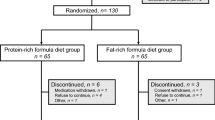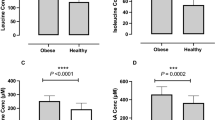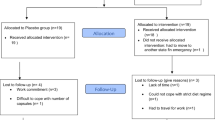Abstract
We previously identified a systemic metabolic defect associated with early weight loss in patients with Huntington's disease (HD), suggesting a lack of substrates for the Krebs cycle. Dietary anaplerotic therapy with triheptanoin is used in clinical trials to promote energy production in patients with peripheral and brain Krebs cycle deficit, as its metabolites – C5 ketone bodies – cross the blood–brain barrier. We conducted a short-term clinical trial in six HD patients (UHDRS (Unified Huntington Disease Rating Scale)=33±13, 15–49) to monitor the tolerability of triheptanoin. We also assessed peripheral markers of short-term efficacy that were shown to be altered in the early stages of HD, that is, low serum IGF1 and 31P-NMR spectroscopy (NMRS) in muscle. At baseline, 31P-NMRS displayed two patients with end-exercise muscle acidosis despite a low work output. On day 2, the introduction of triheptanoin was well tolerated in all patients, and in particular, there was no evidence of mitochondrial overload from triheptanoin-derived metabolites. After 4 days of triheptanoin-enriched diet, muscle pH regulation was normalized in the two patients with pretreatment metabolic abnormalities. A significant increase in serum IGF1 was also observed in all patients (205±60 ng/ml versus 246±68 ng/ml, P=0.010). This study provides a rationale for extending our anaplerotic approach with triheptanoin in HD.
Similar content being viewed by others
Introduction
Huntington's disease (HD) is an inherited severely disabling disorder without curative or preventive treatment. We showed that early weight loss in HD is associated with a systemic metabolic defect, and that branched-chain amino-acid (BCAA) levels can be used as a biomarker, indicative of disease onset and early progression.1 Levels of IGF1, which are regulated by BCAA, were also significantly lower in the HD group.1 The decrease in plasma BCAA observed in our HD group suggested the activation of a compensatory mechanism to provide energy substrates to the Krebs cycle, as described in cachexia-producing illnesses.2 Similarly, dietary compounds such as triheptanoin have been used in human therapeutic trials for their ability to refill the pools of intermediates of the Krebs cycle, a key energetic process known as anaplerosis.3 Owing to additional evidence for triheptanoin metabolites to cross the blood–brain barrier,4 anaplerotic therapies represent promising molecules for reversing the energy deficit observed in both the brain and the periphery in HD patients. On the basis of the hypothesis that there is a need for Krebs cycle energy substrates in HD, we conducted a pilot study using a dietary anaplerotic approach to assess safety and short-term metabolic correction.
Methods
Study design
We included six HD patients with abnormal CAG repeat expansions (mean=46±3) in the HTT gene with a mild-to-moderate disease, measured by the clinical scale UHDRS (Unified Huntington Disease Rating Scale) of 33±13 (Table 1). All participants were enrolled in a clinical protocol promoted by INSERM (COS 07–26, http://bir.inserm.fr), and approved by the local ethics committee. Written informed consent was obtained for all participants.
On the screening day – ∼1 month before the therapeutic trial – motor dysfunction was evaluated with the UHDRS, and each HD participant underwent 31P-NMRS testing in muscle. The six HD patients were asked to fill an opened-ended questionnaire during three consecutive days, so that the dietician could determine their caloric intake and devise daily menus ensuring that triheptanoin oil provides 40% of an isocaloric diet, as established previously.3, 4 At day 1, the six HD participants were hospitalized and height and weight were recorded to calculate the body mass index (BMI). Blood and urine samples were collected after an overnight fast for standard analyses, as well as plasma acylcarnitines, amino acids and ketone bodies, serum IGF1 and urine organic acids, as described previously.4 At day 2, HD patients ingested the first doses of triheptanoin (1 g/kg per day divided in four meals). Repeated blood samples were collected before and, sequentially, after the first meal (30, 60, 90, 120 and 180 min after triheptanoin ingestion) for assessment of acylcarnitines profile, amino acids and ketone bodies. Urine samples were collected before and after the first ingestion of triheptanoin (90 and 180 min) for analyses of organic acids. During the next 3 days, HD participants kept consuming an isocaloric diet enriched with triheptanoin (1 g/kg per day). At day 5, standard analyses were repeated for fasting as well as plasma acylcarnitines, amino acids and ketone bodies, serum IGF1 and urine organic acids. UHDRS scoring was performed and muscle 31P-NMRS was repeated. In view of the low risks to subjects participating in this protocol, continuous and close monitoring by the principal investigator was performed on an ongoing basis during the days the patients were taking triheptanoin – almost all triheptanoin-derived metabolites being used 3–4 h after its administration.4
31P-NMR spectroscopy in muscle
NMR was carried out as described previously.5 Data were analyzed semi-automatically to provide perfusion time course, PCr rephosphorylation time constant (TPCr) and end-exercise acidosis level (pH). The intensity of exercise (W/S) was determined by correcting work output (W, in Joules) developed during exercise to calf muscle area section (S, in cm2).
Statistics
Data are expressed as mean±SEM. Paired t-tests (SPSS, Chicago, IL, USA) were used to compare the values of plasma acylcarnitines, serum IGF1 and UHDRS before and after triheptanoin.
Results
Patients’ BMI ranged from 19 to 25 kg/cm2. There was no correlation between CAG repeats and metabolic measurement at baseline, except for an inverse correlation with plasma glutamine (P<0.001). All patients tolerated the treatment well and no adverse event was monitored during the trial and beyond. As a result of feeding triheptanoin, urinary excretion of derivatives of heptanoate oxidation were detected – pimelate, 6-hydroxyheptanoate, 3-hydroxypentanoate (BHP), 3-ketopentanoate (BKP), 3-hydroxypropionate and methylcitrate – but there was no evidence of mitochondrial overload from triheptanoin-derived metabolites. Among plasma triheptanoin-derived metabolites, there was no substantial increase in either pentanoylcarnitine (C5) or heptanoylcarnitine (C7) (data not shown) but propionylcarnitine (C3) increased significantly in all patients (Table 1), indicating complete β-oxidation of heptanoate to propionyl-CoA. Substantial increases of C5 ketone bodies were observed after meal and triheptanoin administration (data not shown), with BHP to BKP ratios between 2.1 and 2.8. Plasma BCAA levels initially decreased after triheptanoin administration and then returned to their baseline levels on day 5 (data not shown). There was no significant change in UHDRS scores before and after triheptanoin (Table 1). There was no correlation between CAG repeats and the levels of triheptanoin metabolites (data not shown).
During plantar flexion dynamic 31P-NMRS, all HD patients presented with a work output about two- to four-fold lower (Supplementary Table) than that seen in healthy individuals – W/S=34.96±16.35 J/cm2, n=7. Measurements of intramuscular pH showed that two patients (P5 and P6) presented with end-exercise muscle acidosis – pH at 6.72 and 6.84, Figure 1 – despite even lower exercise intensity compared with the four other patients – W/S at 11.44 and 9.40 J/cm2, respectively (Supplementary Table). Creatine rephosphorylation time constant was also increased in these two patients – tPCr of 63.1 and 52.5 s, respectively – but turned out to be normal when corrected for pH.6 It must be noted that patient 5 had lower BMI (that is, 19 kg/cm2), whereas patient 6 had the higher UHDRS score (that is, 49 kg/cm2).
Remarkably, after 4 days of triheptanoin-enriched diet, we observed a correction of end-exercise muscle acidosis – pH at 6.97 and 6.98, Figure 1 – in the two patients with pretreatment metabolic abnormalities (P5 and P6). This was associated with different hyperemic responses after treatment with an earlier return to basal level of perfusion for patient 5 (Figure 2) and the occurrence of a distinct peak of functional hyperemia from the third minute of recovery for patient 6 (Figure 2). In addition, we observed a significant increase in serum IGF1 in all HD patients (Table 1).
Perfusion kinetics during exercise recovery before and after treatment in patients 5 and 6. The global hyperemic response was improved after treatment: more regular and rapid return to basal level for patient 5 (left panel) and distinction of a peak of hyperemia before reaching basal level of perfusion for patient 6 (right panel).
Discussion
On the basis of our observation of a hypercatabolic profile early in HD, our short-term study aimed at directly identifying an energy deficit, followed by a therapeutic intervention to improve peripheral energy metabolism in HD patients. Our anaplerotic approach using dietary triheptanoin was well tolerated in all HD patients, both clinically and biochemically. It is noteworthy that the levels of plasma BCAA decreased temporarily after the initiation of triheptanoin before returning to their baseline levels, likely reflecting the reversible inhibition of branched-chain α-ketoacid dehydrogenase kinase by medium-chain fatty acids.7 Furthermore, we analyzed markers of peripheral energy metabolism that were shown to be altered in early stages of HD, that is, low serum IGF11 or delayed phosphocreatine recovery (tPCr) after exercise measured by 31P-NMR spectroscopy in muscle.8, 9 Although 31P-NMR spectroscopy can lack the sensitivity to detect mitochondrial dysfunction,10 the most noticeable finding from our study was that two patients developed muscle acidosis at baseline while performing a low-intensity exercise. Their end-exercise pH corresponded with W/S ratios three-fold higher than in normal subjects (data not shown). These two patients also had longer tPCrs, but when corrected for pH, tPCrs seemed to be unaltered.6 This observation differs from previous observations, although end-exercise pH was either not reported8 or unaltered in the HD group.9 It is noteworthy that our anaplerotic approach with triheptanoin led to a normalization of end-exercise muscle acidosis in the two patients with pretreatment abnormalities. NMR measurements of muscle perfusion also suggested an effect of triheptanoin on hyperemic responses to exercise. Moreover, the improvement in peripheral energy metabolism in our study is supported by the significant increase in serum IGF1 in all HD patients. IGF1 affects mutant huntingtin by promoting its phosphorylation. Phosphorylation inhibits mutant huntingtin toxicity by restoring its transport function.11, 12 Therefore, the increase in IGF1 after treatment with triheptanoin may exert direct beneficial effects by restoring huntingtin function and/or by blocking huntingtin toxicity in peripheral organs and possibly in the brain. It is not clear how triheptanoin mediates IGF1 levels, especially because triheptanoin did not increase the levels of BCAA – known to regulate IGF1. Ketone bodies cross the blood–brain barrier and ketogenic diet was shown to modulate IGF1 metabolism in the rat brain.13 Similarly, it would be interesting to assess in vitro whether the ketone bodies derived from triheptanoin – that is, BHP and BKP – can modulate IGF1 levels and huntingtin phosphorylation in primary cultures of striatal neurons.
In addition to the prominent role of brain energy deficit in the pathophysiology of HD,14, 15 there are several lines of evidence for a more systemic energy deficit. Our findings of hypercatabolism in HD1 were indeed recently confirmed in both clinical16, 17 and preclinical studies.18, 19 Our data emphasize that 31P-NMRS may provide relevant biomarkers of peripheral energy metabolism in HD. This study also provides a rationale for extending our anaplerotic approach with triheptanoin in HD. A double-blind placebo-controlled trial with clinical outcome measurements is planned to confirm the potential benefit of anaplerotic therapies to improve, or even reverse, the energy deficit both in the periphery and the brain of HD patients and presymptomatic individuals.
References
Mochel F, Charles P, Seguin F et al: Early energy deficit in Huntington disease: identification of a plasma biomarker traceable during disease progression. PLoS One 2007; 2: e647.
De Bandt JP, Cynober L : Therapeutic use of branched-chain amino acids in burn, trauma, and sepsis. J Nutr 2006; 136: 308S–313S.
Roe CR, Mochel F : Anaplerotic diet therapy in inherited metabolic disease: therapeutic potential. J Inherit Metab Dis 2006; 29: 332–340.
Mochel F, DeLonlay P, Touati G et al: Pyruvate carboxylase deficiency: clinical and biochemical response to anaplerotic diet therapy. Mol Genet Metab 2005; 84: 305–312.
Duteil S, Bourrilhon C, Raynaud JS et al: Metabolic and vascular support for the role of myoglobin in humans: a multiparametric NMR study. Am J Physiol Regul Integr Comp Physiol 2004; 287: R1441–R1449.
Iotti S, Lodi R, Frassineti C, Zaniol P, Barbiroli B : In vivo assessment of mitochondrial functionality in human gastrocnemius muscle by 31P MRS. The role of pH in the evaluation of phosphocreatine and inorganic phosphate recoveries from exercise. NMR Biomed 1993; 6: 248–253.
Harris RA, Joshi M, Jeoung NH : Mechanisms responsible for regulation of branched-chain amino acid catabolism. Biochem Biophys Res Commun 2004; 313: 391–396.
Lodi R, Schapira AH, Manners D et al: Abnormal in vivo skeletal muscle energy metabolism in Huntington's disease and dentatorubropallidoluysian atrophy. Ann Neurol 2000; 48: 72–76.
Saft C, Zange J, Andrich J et al: Mitochondrial impairment in patients and asymptomatic mutation carriers of Huntington's disease. Mov Disord 2005; 20: 674–679.
Laforet P, Wary C, Duteil S et al: [Exploration of exercise intolerance by 31P NMR spectroscopy of calf muscles coupled with MRI and ergometry]. Rev Neurol (Paris) 2003; 159: 56–67.
Zala D, Colin E, Rangone H, Liot G, Humbert S, Saudou F : Phosphorylation of mutant huntingtin at S421 restores anterograde and retrograde transport in neurons. Hum Mol Genet 2008; 17: 3837–3846.
Humbert S, Bryson EA, Cordelieres FP et al: The IGF-1/Akt pathway is neuroprotective in Huntington's disease and involves Huntingtin phosphorylation by Akt. Dev Cell 2002; 2: 831–837.
Cheng CM, Kelley B, Wang J, Strauss D, Eagles DA, Bondy CA : A ketogenic diet increases brain insulin-like growth factor receptor and glucose transporter gene expression. Endocrinology 2003; 144: 2676–2682.
Browne SE, Beal MF : The energetics of Huntington's disease. Neurochem Res 2004; 29: 531–546.
Cui L, Jeong H, Borovecki F, Parkhurst CN, Tanese N, Krainc D : Transcriptional repression of PGC-1alpha by mutant huntingtin leads to mitochondrial dysfunction and neurodegeneration. Cell 2006; 127: 59–69.
Aziz NA, van der Burg JM, Landwehrmeyer GB, Brundin P, Stijnen T, Roos RA : Weight loss in Huntington disease increases with higher CAG repeat number. Neurology 2008; 71: 1506–1513.
Goodman AO, Murgatroyd PR, Medina-Gomez G et al: The metabolic profile of early Huntington's disease–a combined human and transgenic mouse study. Exp Neurol 2008; 210: 691–698.
van der Burg JM, Bacos K, Wood NI et al: Increased metabolism in the R6/2 mouse model of Huntington's disease. Neurobiol Dis 2008; 29: 41–51.
Zabel C, Mao L, Woodman B et al: A large number of protein expression changes occur early in life and precede phenotype onset in a mouse model for Huntington disease. Mol Cell Proteomics 2009; 8: 720–734.
Acknowledgements
We thank the patients and their trust in new therapeutic avenues, the Centre d’Investigation Clinique and his devoted team, as well as Josiane Sage for her contribution to the study design, Anne Defarge and the Department of Dietetics for their help with the dietary assessment, and Pr Alexis Brice and Dr Raphael Schiffmann for their critical reading of the paper.
Author information
Authors and Affiliations
Corresponding author
Ethics declarations
Competing interests
Drs Mochel and Durr may accrue revenue on patent EP 06291873.5, issued: 12 April 2006: Anaplerotic therapy of Huntington's disease and other polyglutamine diseases (BIO06353).
Additional information
Supplementary Information accompanies the paper on European Journal of Human Genetics website
Supplementary information
Rights and permissions
About this article
Cite this article
Mochel, F., Duteil, S., Marelli, C. et al. Dietary anaplerotic therapy improves peripheral tissue energy metabolism in patients with Huntington's disease. Eur J Hum Genet 18, 1057–1060 (2010). https://doi.org/10.1038/ejhg.2010.72
Received:
Revised:
Accepted:
Published:
Issue Date:
DOI: https://doi.org/10.1038/ejhg.2010.72
Keywords
This article is cited by
-
Ghrelin rescues skeletal muscle catabolic profile in the R6/2 mouse model of Huntington’s disease
Scientific Reports (2017)
-
Alternative Fuels in Epilepsy and Amyotrophic Lateral Sclerosis
Neurochemical Research (2017)
-
Glucose transportation in the brain and its impairment in Huntington disease: one more shade of the energetic metabolism failure?
Amino Acids (2017)
-
Modification of Astrocyte Metabolism as an Approach to the Treatment of Epilepsy: Triheptanoin and Acetyl-l-Carnitine
Neurochemical Research (2016)





